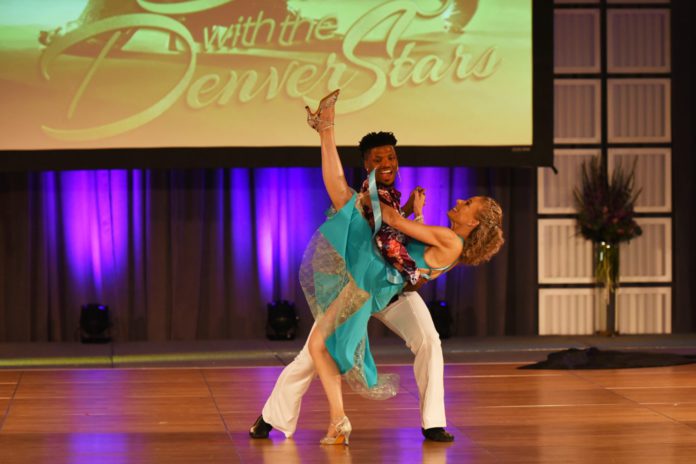
In 2016, Polsinelli shareholders Colleen Faddick and Bruce Johnson attended Dancing with the Denver Stars, a charity event they had learned about from a client. They didn’t know what to expect from the annual gala held by Cleo Parker Robinson Dance, but once they saw local business leaders and politicians take the stage to show off their moves alongside professional dancers, they were hooked.
“Bruce and I looked at each other and we thought, how do we do this?” Faddick said. “I think it was just the energy and the excitement and what looked to be a ridiculous amount of fun that got us involved in wanting to do it.”
Johnson went on to perform the next year, dancing to “Love Machine” by The Miracles at the Motown-themed gala, and Faddick took the stage in 2018 when the theme was “Vegas.” She danced to a mix of Michael Jackson’s “The Way You Make Me Feel” and Diana Ross tunes from “The Wiz.”
The fundraiser’s cast of stars typically includes at least one or two lawyers, and those who have participated say the benefits of dance go beyond raising money for a good cause, with positive effects on mental and physical health.
“Every person that does Dancing with the Stars loses weight,” Johnson said. “I’ve been able to keep weight off and keep myself healthy by dancing along with other different types of physical exercise.”
“I think, for a lawyer, the physical and the mental are completely interconnected. My brain works better after I’ve worked out,” said Johnson, who continues to take dance classes through CPRD. He said he usually works four or five hours on Saturdays, starting his day at the office then leaving for a hip-hop class around 10 a.m. After class he’s “exhausted,” he said, “but then I come back and I work till one o’clock, and my brain is in just a completely different space.”
“For me, it was less about the physicality of it and more the freedom,” Faddick said. “Our jobs are very regimented. … It’s high intensity. And it’s nice to have an avenue to let that go.” Unlike other forms of exercise that allow the mind to wander to a memo that needs to be written, she said, “when you’re dancing, at least for me, one of the freeing things about it is that you can’t pay attention to dancing and be thinking about something else.”
Lisa Hogan, shareholder at Brownstein Hyatt Farber Schreck, performed an aerial silks routine she choreographed with her dance partner at the gala event in 2016. Hogan also serves on CPRD’s board of directors and chairs the organization’s capital campaign.
“It’s so beyond the physical dance,” she said of her interest in the 50-year-old dance school, which aims to “[leverage] the universal language of dance to honor African American heritage, explore the human condition, and offer a transformative experience through physical movement,” according to its website.
Cleo Parker Robinson, the organization’s internationally renowned founder and artistic director, is a native of Denver’s Five Points neighborhood, and Hogan said CPRD and the African Methodist Episcopal church it occupies are important parts of the neighborhood’s culture and history.
“As the city grows and the Five Points area is gentrifying so much, one of the really key things, especially for those of us who are from Denver, is to not lose the spirit and the heritage of that area,” she said.
“They’re huge in community unification and just do so much for the community,” Hogan said of CPRD. “[Robinson] has always been very much a social activist, but she expresses it through the medium of dance.”
“It’s a dance studio, it’s a professional dance company, but it’s also a community-based social services organization to a great degree,” said Johnson. Proceeds from the Dancing with the Denver Stars event go toward funding CPRD’s arts education programs, which serve 20,000 students in 80 schools each year.
The 2020 event was canceled due to the pandemic, as were a slew of other events intended to mark the organization’s 50th anniversary. But the pandemic hasn’t stopped people from dancing and moving.
CPRD continues to offer outdoor classes and online videos. “They have done a really, really good job over COVID trying to find ways to engage with people,” Faddick said.
Johnson has attended some outdoor classes, and for at-home exercise, he’s partial to a Zumba video by one of CPRD’s former dancers. “I’ve probably done it 25 times,” he said.
“I think the point of dancing — if it needs to have any kind of point at all — is it’s intentional, physical movement,” said Hogan. “It’s expressive. And anything that gets us out of our everyday life and moving is a really good thing.”
Hogan has been teaching yoga classes online to attorneys and staff at her firm during the pandemic. She sees dance and yoga as complementary forms of intentional movement, with the main benefit of yoga coming from deep breathing, which helps shut off the adrenaline and cortisol that so many Type-A personalities live on.
“That’s especially important for lawyers and the people who work with them and love them, is trying to get everybody to focus on getting to a level of calm, where your level of discernment in your thinking is heightened and focused,” she said.
—Jessica Folker

